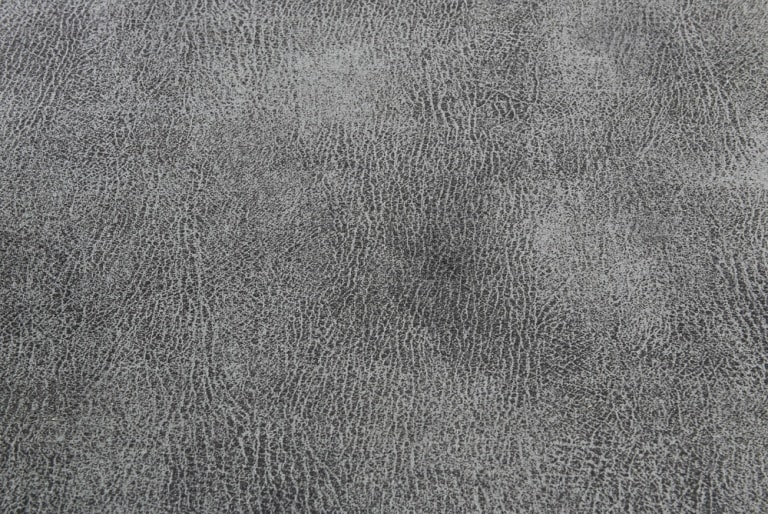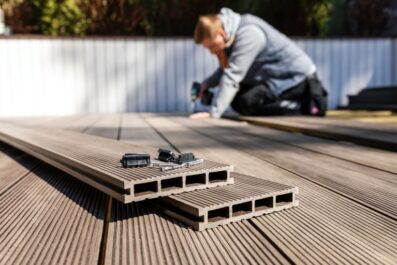Farmhouse Stained Concrete Floors: Are They Right for Your Home?

More and more homeowners are being swayed by the charms of stained concrete flooring for their farmhouse styling endeavors.
This shouldn’t come as a surprise; after all, stained concrete flooring is gorgeous, versatile, long-lasting, and –on top of all that– affordable!
Farmhouse stained concrete floors are undoubtedly an aesthetically pleasing, reliable, and high-value option, but are they the right move for your project?
In today’s guide, I’m explaining what stained concrete floors are and comparing their pros and cons. I also share some practical tips to keep your stained concrete floors in shape!
What Are Stained Concrete Floors?
Stained concrete floors are made of concrete treated with a stain to give it a rich and patterned color. The used stain can be water- or acid-based.
When the stain is added to the concrete, its particles penetrate the surface and reach deeper into the material. This causes the resulting color to be tightly bound to the concrete so it doesn’t chip, peel, or fade away quickly.
In other words, staining makes the color effect in the concrete permanent.
When staining concrete, professionals can use various colors and variegation techniques to produce a wider variety of floor designs.
Stained Concrete vs Dyed (Colored) Concrete
While researching stained concrete floors, you’ll likely come across another term that refers to treated concrete – dyed or colored concrete.
Stains and dyes differ in their composition, application, and final look. So, you must understand the difference between stained and dyed concrete to ensure you choose the most suitable flooring option for your property.
In stained concrete, the stain reacts with the minerals existing in the concrete, which allows it to move beyond the surface and produce colors at deeper levels (but not all the way through).
Additionally, staining is a process that’s done on existing concrete slabs. Its technique also allows for producing more color and design variations. It can even mimic the finish of other materials, such as polished marble and natural stone.
As for dyed concrete, the color is added before the concrete is made, not to an existing slab. The pigment is incorporated into the concrete mix that’s then poured and molded.
This results in evenly colored concrete slabs with consistent pigmentation from one side to the other. This technique is best for creating solid coloration in concrete slabs.
Why Choose Stained Concrete Floors When Farmhouse Styling?
Stained concrete floors come with a set of tempting advantages that I’ll break down for you in the following points:
A Variety of Shades and Designs
Stained concrete floors offer great flexibility for farmhouse styling.
You can use a wide range of colors and hues to achieve as much of a customized appearance as your project requires. From neutral tones to bright shades, there’s virtually no limit to the coloration staining can produce.
You can even go for combinations of colors on the same concrete slab!
Additionally, you can create any pattern you’d like when you stain concrete. You can go for minimal borders, marbling, waves, swirls, stenciled shapes, intricate variegation, or anything.
This boosts the personalization factor of stained concrete floors, allowing you to achieve a look that matches your aesthetic vision.
Natural Materials’ Finish
The staining technique of adding color to concrete floors makes it possible to get the appearance of natural materials at a reduced cost.
Stained concrete can get the job done if you’re looking to achieve the realistic-looking finish of stone, marble, or even wood without breaking the bank.
No Color Fading
One of the best aspects of stained concrete flooring is that you won’t have to worry about the colors or patterns fading, chipping, or peeling over time.
The application of the stain makes it so the pigment is embedded into the concrete material so it takes on the chosen shades permanently.
Floor Finishes Pairing
After staining the concrete slabs, they can undergo polishing without affecting the coloring job.
Stained concrete flooring can take it, whether it’s a glossy coating or a matte seal for protection against abrasions or for added visual effects.
Long Lifespan
Stained concrete floors are known for their impressive durability. Proper installation and sealing make for a fantastic flooring option in areas with heavy foot traffic.
The extra coating adds to the resilience of concrete and reinforces it with resistance against moisture, stains, chips, and scratches.
High Value for Money
Stained concrete floors are typically more affordable than other types of flooring, such as natural stone, ceramic tiles, and hardwood. They’re even extra cost-effective if you already have concrete slabs installed.
Radiant Heating Compatibility
If you have a radiant heating system or plan to install it, you should consider stained concrete floors.
They’re compatible with such systems thanks to the thermal mass of concrete that enables uniform and efficient heat distribution.
Good for the Environment
If you’re worried about your project’s environmental impact, stained concrete floors offer you the chance to reduce your carbon footprint. Working with existing concrete slabs eliminates the need to manufacture and transport flooring materials.
Low Maintenance
Stained concrete floors don’t require much effort on your part to stay looking fresh.
You don’t need to worry about polishing, waxing, and using special cleaners – just regular cleaning occasionally is enough to keep their appearance in check.
Property Value Boost
The beautiful appearance of stained concrete floors, plus all the other advantages listed above, make them a valuable addition to any property. Think of this type of flooring as an investment for whenever you decide to bring in a tenant or buyer.
Are There Disadvantages to Farmhouse-Style Stained Concrete Floors?
No flooring option is perfect, and stained concrete is no exception. Here are some of its disadvantages that you should keep in mind:
- The staining process isn’t a project you can DIY if you’re a beginner. It usually requires hiring a professional.
- Stained concrete is durable but also challenging, making it uncomfortable to walk around, especially for sensitive feet. This hardness also increases the risk of fall accidents (kids and elderly) and breakage upon impact (unless adequately sealed).
- Concrete can feel cold in winter if you don’t have a radiant heating system or area rugs.
- Stained concrete flooring may not respond well to harsh chemicals, so it’s best to use mild or natural cleaners.





